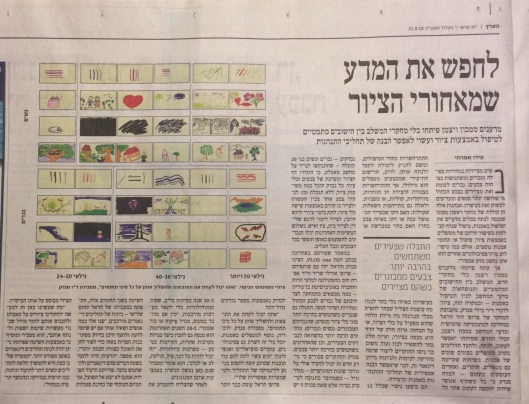
לחפש את המדע שמאחורי הציור
31 Wednesday Aug 2016
Posted in כללי
31 Wednesday Aug 2016
Posted in כללי

15 Monday Aug 2016
Posted in כללי
שלום לכולם!
אנו מזמינים אתכם לקרוא על יום העיון שנערך במרכז המחקר לרגל חמש שנות מחקר. תוכלו לגשת לסריקה של הכתבה בלינק למעלה.
08 Monday Aug 2016
Posted in כללי
אנו מזמינים אתכם לצפות בסרטון חדש של אגודת ידידי אוניברסיטת חיפה, המציג 3 פרוייקטים נבחרים- ביניהם פרוייקט של מרכז המחקר!
לצפייה לחצו:
03 Wednesday Aug 2016
Posted in כללי
אנו מזמינים אתכם להאזין לתכנית הרדיו “אמנות הטיפול”, במסגרתה רואיינה פרופ’ כוכבית אלפנט, חוקרת המרכז, אודות תרפיה במוזיקה. תוכלו להאזין לתכנית בלינק הבא:
01 Monday Aug 2016
Posted in כללי
התבוננות בציורי “אדם קוטף תפוח מהעץ” בטיפול באמנות מסייעת להיכרות קרובה עם רבדים שונים בעולמו הפנימי של המטופל. הבנה זו הובילה למחקר חלוץ בישראל על הקשרים שבין תכניו הסימבוליים של הציור, ובין חווייתו הרגשית של המצייר בקרב ילדים ומבוגרים.
מחקרה של ד”ר מיכל בת אור בדק את הקשרים שבין התוכן הסימבולי (כמו מידת האקטיביות של דמות הקוטף) בציורי ״אדם קוטף תפוח מהעץ״ של 215 בוגרים צעירים (בגילאי 20-35 שנים), כפי שאלו קשורים אל סגנונות ההתקשרות שלהם. סגנונות ההתקשרות נמדדו ע״י שאלון דיווח עצמי המודד את חוייתם בתוך קשרים קרובים. הציורים דורגו ע״י שופטים מהימנים עפ״י סולם דירוג המודד תכנים סימבוליים בציור. עבור כלל המדגם לא נמצא קשר בין תוכן הציור ובין סגנונות ההתקשרות, אך כאשר המדגם חולק לקבוצות עפ״י סגנונות ההתקשרות, נמצא כי: בציוריהם של בעלי סגנון ההתקשרות הבטוח, נמצא תסריט שבו יש הדדיות בין האובייקטים המצויירים- אדם, עץ ותפוחים, כך שהקשרים שבין האובייקטים הופכים את הקטיף לפעולה פשוטה (לדוגמא, ככל שהאדם פעיל יותר בציור, כך העץ נוטה יותר לכיוונו של הקוטף והקטיף פשוט יותר), בעוד שבציוריהם של בעלי סגנונות ההתקשרות הלא בטוחה, נמצאו קשרים מעורבים ולעיתים סותרים בין האובייקטים המצויירים (למשל, ככל שיש יותר תפוחים על העץ, כך העץ גבוה יותר ביחס לאדם, וכך גם קשה לו לקטוף אותם). מתוך ממצאים אלו, ניתן להבחין בקשר שבין סגנונות ההתקשרות ובין איכות התסריט הפנימי שיש לאדם בהקשר להשגת מטרותיו (למשל באמונה הפנימית: עד כמה הסביבה מסייעת לי להגיע למטרותיי, או עד כמה הסביבה דו-ערכית או עויינת). הממצאים מחזקים את הסברה שציור השלכתי אכן יכול לעזור לשקף לאדם את חווייתו הפנימית, ולהוות נדבך בדרך להשגת שינוי טיפולי ולעודד צמיחה אישית.
הממצאים מתקפים את ההערכה המבוססת אמנות– ציור ״אדם קוטף תפוח מהעץ״ כהערכה שאכן משקפת רבדים עמוקים בנפשו של האדם. בנוסף, מתוך תשומת לב מדוקדקת לאיכות היחסים שבין האובייקטים המצויירים, ניתן לזהות את חווייתו האישית של המצייר, ואף להרחיב את ההבנה שלנו על סגנונות ההתקשרות, ובעיקר על הרובד הלא מודע.
04 Tuesday Aug 2015
Posted in כללי
Conference of Hyperbaric Oxygen and the Brain_ Dead see 2015 (1)
Dear all,
Please find attached the invitation to the conference.
Prof. Rachel Lev, head of the Emili Sagol research center, will present for the first time the preliminary results of her innovative research about the use of hyperbaric oxygen for healing emotional trauma in child sexual abuse survivors. More details will be given soon!
We will be happy to see you in the conference!
23 Thursday Jul 2015
Posted in כללי
How Your Body Affects Your Happiness: Tal Shafir at TED
Dr. Tal Shafir has had a special passion for movement and dance since young age. As an adult she wanted to bring their exhilarating effects on mood and well being to other people. Thus, after graduating with her LLB degree from The Hebrew University of Jerusalem and becoming a lawyer, she studied dance-movement therapy, as soon as those studies became available in Israel. While working with neurologically impaired children, the desire to design better interventions prompted her to go back to school to study neuro-physiology of motor control. Once in school, she was drawn to research and decided to continue her career in academia.
20 Monday Jul 2015
Posted in כללי
We invite you to read an article which was recently published about one of our researcher’s work- Mr. Pavel Goldstein.
http://www.haaretz.com/life/science-medicine/.premium-1.665782#
16 Thursday Jul 2015
The Emili Sagol Creative Arts Therapies Research Center is proud to present a recently launched innovative project that will help disperse practice-based knowledge among professionals, encourage professionals to develop new tools, measures, and therapeutic techniques, and validate existing evaluation measures.
We are currently collecting practice-based knowledge, methods of assessment, and intervention techniques in the field of creative arts therapies.
The goal of this project is to distribute this knowledge between social service providers, policy makers, and researchers, in a way that will benefit both society and professionals. These resources will be available via an internet database, the creative arts therapies kit, named KIT CAT (Knowledge Intervention Techniques in Creative Arts Therapies).
Professionals in the fields of creative arts therapies and social work are invited to contribute their developments to this database. The material will be peer reviewed before publication. We are looking for new data in the form of videos, photos, articles and any other format. All original material will be protected and all credit will be given to the appropriate parties.
We believe it is time for practitioners and professional in the field of creative arts therapies to share their knowledge and innovations with the world (within Israel and abroad), in order to better the lives of their clients.
If you are interested in taking part in our interactive learning manual and receive instructions for submissions to the database, please send an e-mail to catrc@univ.haifa.ac.il. We look forward to collaborating with you.